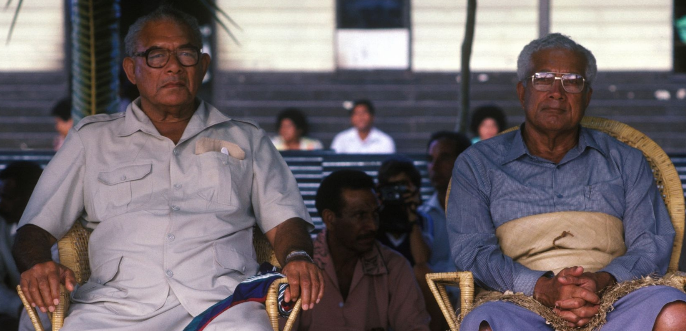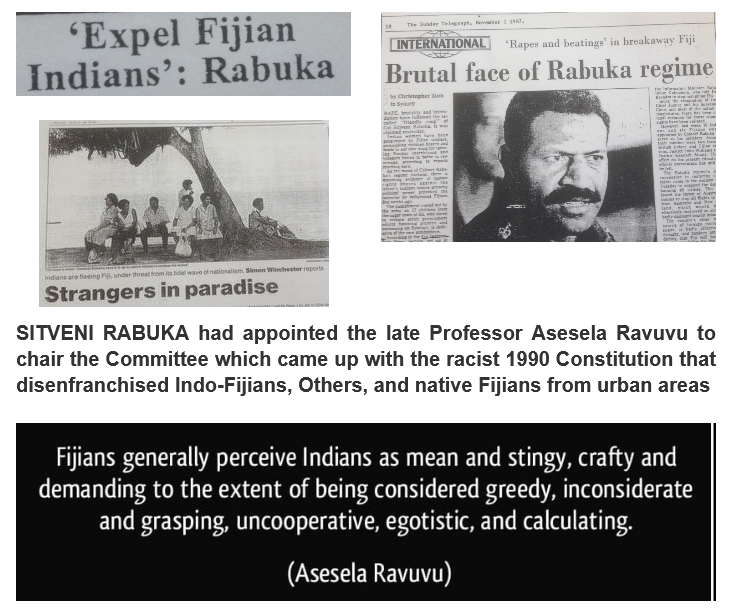Sitiveni Rabuka's Cakaudrove paramount chief, Ratu Sir Penaia Ganilau, was appointed to preside over the overtly racist 1990 Constitution of Fiji that introduced South African style apartheid in Fiji. Approved by the Great Council of Chiefs, the Constitution had entrenched i-Taukei political supremacy in perpetuity. The new post-coup president Ratu Sir Penaia Ganilau, echoing the high-priest and architect of racism in South Africa, Dr H. F. Verwoerd, had affirmed primacy of race in Fiji. He had also defended Rabuka's enshrinement of Christianity as a state religion. Ganilau was supported by his post coup Prime Minister and later President, Ratu Sir Kamisese Mara who insisted the 1990 racist Constitution addressed 'the rights and aspirations' of the i-Taukei population'. These pronouncements, however, did not represent the majority opinion. As a Maori professor, Ranginui Walker, declared in Auckland in 1987:
'The coup is nothing more than a shameful use by an oligarchy that refuses to recognize and accept the winds of change in Fiji. It would appear from the distance that the Great Council of Chiefs, still living in their traditional ways, have been misled. Their land rights are secure under the 1970 constitution. But because they have not been taught their rights they are readily manipulated and swayed by demagogues.'
Fijileaks: The appointment of Ratu Wiliame Katonivere has nothing to do with the Deed of Cession. His appointment as new president is an insurance, to ensure FFP remains in power by hook or crook
By VICTOR LAL
The 1990 Constitution:
This Constitution brought me into direct conflict with Mara, Ganilau and Rabuka when the late Professor Asesela Ravuvu and I exchanged sharp words at the British Foreign and Commonwealth Office seminar in London on the constitutional developments in Fiji after the 1987 coups. Also present across the table was Ratu Epeli Nailatikau, then Rabuka's High Commissioner to London, and later the post-Ghai constitution President of Fiji. It was at this seminar where I repeated what I had told the British television audience: "The 1987 coups raise one and only question: how many generation does one have to wait to become a native. My ancestors were coolie Indians, not ME or my fellow Indo-Fijians." Defending the nauseating racial and constitutional developments was Isikeli Mataitoga, later High Court judge after the Bainimarama coup. Mataitoga is now ensconced in Japan as Fiji's ambassador.
The 1990 Constitution also led to arrests, beatings, and tortures when a group of Indo-Fijians, led by Dr Anirudh Singh, set fire to this Constitution in public as a mark of protest. In our fight for Indo-Fijian rights was a fellow young traveller Aiyaz Sayed Khaiyum, later FFP Attorney-General and Minister for Justice. He is credited as one of the architects of the 2013 Constitution of Fiji.
The 1990 Constitution:
This Constitution brought me into direct conflict with Mara, Ganilau and Rabuka when the late Professor Asesela Ravuvu and I exchanged sharp words at the British Foreign and Commonwealth Office seminar in London on the constitutional developments in Fiji after the 1987 coups. Also present across the table was Ratu Epeli Nailatikau, then Rabuka's High Commissioner to London, and later the post-Ghai constitution President of Fiji. It was at this seminar where I repeated what I had told the British television audience: "The 1987 coups raise one and only question: how many generation does one have to wait to become a native. My ancestors were coolie Indians, not ME or my fellow Indo-Fijians." Defending the nauseating racial and constitutional developments was Isikeli Mataitoga, later High Court judge after the Bainimarama coup. Mataitoga is now ensconced in Japan as Fiji's ambassador.
The 1990 Constitution also led to arrests, beatings, and tortures when a group of Indo-Fijians, led by Dr Anirudh Singh, set fire to this Constitution in public as a mark of protest. In our fight for Indo-Fijian rights was a fellow young traveller Aiyaz Sayed Khaiyum, later FFP Attorney-General and Minister for Justice. He is credited as one of the architects of the 2013 Constitution of Fiji.









